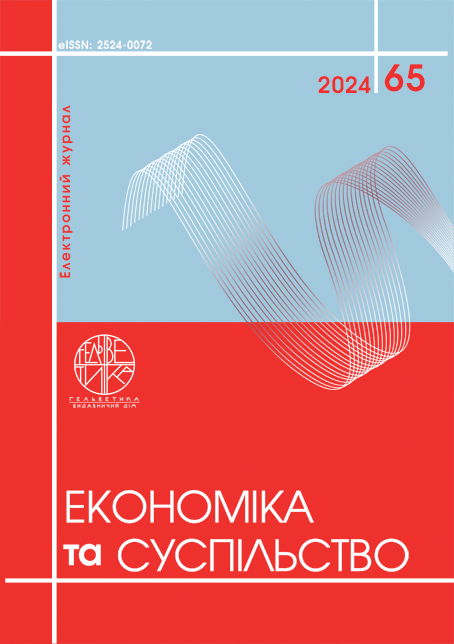ASYMMETRY IN INTERNATIONAL TRADE AND ECONOMIC RELATIONS: SOURCES OF ORIGIN AND FORMS OF MANIFESTATION
Abstract
A fundamental characteristic of international trade and economic relations is the disproportionality of the development of national economies. The article is devoted to defining the essence, sources of occurrence and forms of manifestation of asymmetry in international trade and economic relations. Based on the generalization of approaches to the interpretation of this concept, asymmetry in international trade and economic relations is defined as a violation of the symmetry of such relations, which will be manifested in the uneven distribution of economic potential, resources, technologies and other factors among their participants. Based on the understanding of asymmetry as an integral characteristic of trade relations since their inception, the factors of asymmetry (geographical, technological, political, socio-cultural) are determined and their influence on international trade and economic relations is characterized. The sources of asymmetry in international trade and economic relations determine the forms (directions) of its manifestation. The article substantiates that the asymmetry of international trade and economic relations should be considered as a derivative of the asymmetries of global development (economic, investment, informational, social), which directly affect the possibilities of realizing the potential of countries on world markets. The sources of asymmetry in trade and economic relations of countries are determined by previously significant and systematized factors, the forms of manifestation of which include: imbalance of trade exchange, unequal conditions of competition, difference in access to markets, dependence on investments, differences in production costs. The identified manifestations of asymmetries emphasize their derivative character from asymmetries of global development and are a logical result of asymmetries in international trade and economic relations. In turn, the results of determining the essence of the asymmetry of international trade and economic relations create grounds for analyzing preferential trade and economic agreements concluded between partners with disproportionate rates and levels of economic development.
References
Словник іншомовних слів: 23 000 слів та термінологічних словосполучень / Уклад. Л. О. Пустовіт та ін. К.: Довіра, 2000. С. 834–835.
Asymmetry. Merriam-Webster.com Dictionary. URL: https://www.merriam-webster.com/dictionary/asymmetry (дата звернення 1.08.2024).
Кравчук Н.Я. Асиметрії і дисбаланси глобального розвитку: ідейно-теоретичні та фундаментальні основи. Міжнародна економічна політика. 2011. Вип. № 1-2. С. 170–210.
Krugman P. Is Bilateralism Bad? [In: International Trade and Trade Policy. Edited by Elhanan Helpman and Assaf Rasin]. Cambridge, MA: MIT Press, 1991. pp. 9–23.
Frankel J., Stein E., Wei S. Continental Trading Blocs: Are They Natural or Super-Natural? [In: The Regionalization of the World Economy]. University of Chicago Press, 1996. pp. 91–120.
Hadjiyiannis C. Regionalism and Multilateral Trade Liberalization with Asymmetric Countries. Review of International Economics. 2004. Vol. 12. Issue 3. pр. 395–411.
Балежентіс А., Яценко О. Асиметрії торговельної інтеграції України та ЄС. Міжнародна економічна політика. 2018. № 1 (28). С. 32–62.
Чугаєв О.А. Торговельна інтеграція в умовах асиметрії країн. Вісник Харківського національного університету ім. В.Н. Каразіна. 2016. Вип. 90. С. 164–172.
Kalyuzhna N., Kudyrko L. Effectiveness of trade and economic integration of asymmetric countries: Assessment methods and tools. Journal of Economy and Technology. 2023. vol. 1. pp. 119–126.
Запухляк В.З., Герман Л.Т. Асиметрії глобального економічного розвитку. Економічний аналіз. 2014. Т. 18. № 3. С. 16–25.
Дугінець Г.В. Інформаційна асиметрія в світовій економіці. Економічний простір. 2019. № 150. С. 25–29.
Krugman P., Obstfeld M., Melitz M. International Economics: Theory and Policy. 10th edition. Pearson Education, 2014. 792 p.
Pustovit L., et al (2000). Slovnyk inshomovnykh sliv: 23 000 sliv ta terminolohichnykh slovospoluchen [Dictionary of foreign words: 23,000 words and terminological phrases]. K.: Dovira, pp. 834–835.
Asymmetry. Merriam-Webster.com Dictionary. Available at: https://www.merriam-webster.com/dictionary/asymmetry (accessed 1.08.2024).
Kravchuk N. (2011). Asymetrii i dysbalansy hlobalnoho rozvytku: ideino-teoretychni ta fundamentalni osnovy [Asymmetries and imbalances of global development: ideological and theoretical and fundamental foundations]. Mizhnarodna ekonomichna polityka, 1-2, pp. 170–210.
Krugman P. (1991). Is Bilateralism Bad? In: International Trade and Trade Policy. Edited by Elhanan Helpman and Assaf Rasin. Cambridge, MA: MIT Press, pp. 9–23.
Frankel J., Stein, E. and Wei, S. (1996). Continental Trading Blocs: Are They Natural or Super-Natural? In: The Regionalization of the World Economy. University of Chicago Press, pp. 91–120.
Hadjiyiannis C. (2004) Regionalism and Multilateral Trade Liberalization with Asymmetric Countries. Review of International Economics, no 3, pp. 395–411.
Balezhentis A., Yatsenko O. (2018). Asymetrii torhovelnoi intehratsii Ukrainy ta YeS [Asymmetries of the trade integration of Ukraine and the EU]. Mizhnarodna ekonomichna polityka, no 1(28), pp. 32–62.
Chuhaiev O. (2016). Torhovelna intehratsiia v umovakh asymetrii krain [Trade integration in conditions of asymmetry of countries]. Visnyk Kharkivskoho natsionalnoho universytetu im. V.N. Karazina, 90, pp. 164–172.
Kalyuzhna N., Kudyrko L. (2023). Effectiveness of trade and economic integration of asymmetric countries: Assessment methods and tools. Journal of Economy and Technology, no 1, pp. 119–126.
Zapukhliak, V., Herman, L. (2014). Asymetrii hlobalnoho ekonomichnoho rozvytku [Asymmetries of global economic development]. Ekonomichnyi analiz, 18, 3, pp. 16–25.
Duhinets, H. (2019). Informatsiina asymetriia v svitovii ekonomitsi [Information asymmetry in the world economy]. Ekonomichnyi prostir, no 150, pp. С. 25–29.
Krugman, P., Obstfeld, M., and Melitz, M. (2014). International Economics: Theory and Policy (10th ed.), Pearson Education, 792 p.

This work is licensed under a Creative Commons Attribution 4.0 International License.


